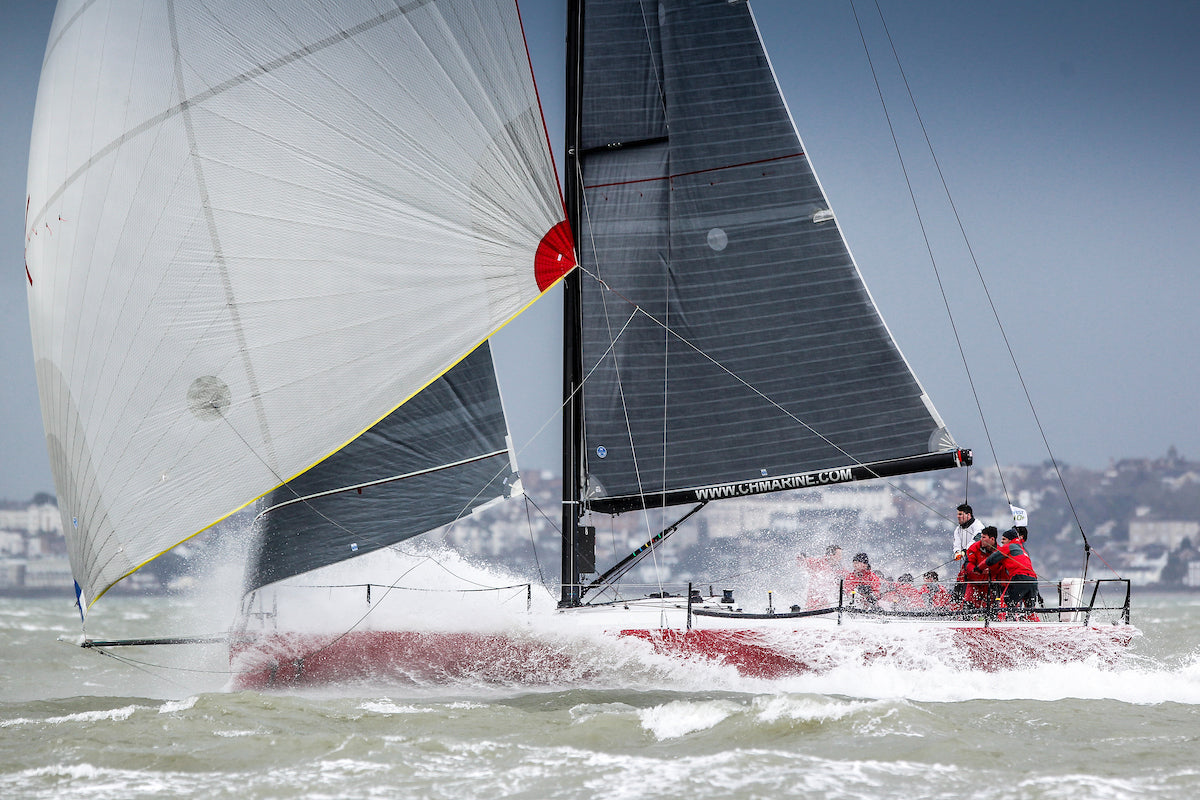STEERING DOWNWIND
STEERING DOWNWIND: LESS IS MORE
Coordinating Commands To Perfect Downhill Steering

Steering off the wind, on reaches and runs, requires a coordinated effort between helmsman and spinnaker trimmer. The spinnaker trimmer often has as good a feel for performance as you do while driving, and together you can coordinate efforts to take advantage of changes in conditions. Of course, as the helm, you must respond to other inputs as well. The tactician may suggest one move, and changing sailing conditions may suggest another. At the same time, you are trying to respond to the trimmer’s input based on sheet load and boat speed. More often than not there are conflicting suggestions: Go up. Go down. Be more aggressive. Steer less.
One effective communication path is to channel all suggestions through the trimmer. Since your tactics won’t succeed without good trim, it helps to keep the trimmer in the communications loop. It also makes life easier for the helm, since you’ll only need to listen and respond to one voice.

Steering on The Reach
Light to Moderate Air
The shortest distance between two points is a straight line… at least, on a reach it is. Plan your reaches with this as the basic tenet. From there you will have to make modifications based on tactics and changes in the sailing conditions.
In fluctuating wind conditions, work up in the lulls and down in the puffs as necessary to maintain speed, while holding a good average course. Ask the trimmer to indicate when the sheet load is light (head up), and when the spinnaker sheet is fully loaded (bear off). The amount of course change required depends on wind speed.
Tactically on a reach there are times when you must head up abruptly, either in an effort to pass another boat or to defend your position. Alerting the trimmers prior to the move improves the chances of success. Any abrupt course change without warning your trimmers will usually doom the maneuver to failure.

Heavy Air
In heavy air, you are at the mercy of your trimmers. The vang, main sheet, and spinnaker sheet must be eased when the boat is overpowered or it will round up and broach. It is fast to carry as much power as you can as long as you can control it. Carrying weather helm is OK as long as the rudder doesn’t stall, leading to a round up. Keep a hand on the vang, and dump it when the helm is on the verge of stalling.
Don’t let an occasional round up discourage you. Regroup and see how long you can go before you round up again. If you do broach, you can speed the recovery by luffing the main and spinnaker. Bear off to a course below your desired sailing angle before you trim. Work up to a reaching course again only after you regain control at a lower angle.
Aggressive trim is needed in puffy conditions to relieve helm load and build speed. Easing the sails in puffs translates the force of the puff into speed rather than heeling force. If the course to the mark is right at the cusp between spinnaker and jib, then a change to a Code Zero can bring control and blazing speed. If you don’t have a Code Zero, sail a little low of course with the spinnaker, and then change to a jib when it is time to reach up. Do not try to sail the cusp with either spinnaker or jib.
Steering on the Run
Goals on a run vary with the wind speed and boat type. The ideas presented here are accurate for moderate displacement keelboats. Priorities will be quite different on an ultralight sportboat. Regardless of your boat type, it is critical that both driver and trimmers are working toward the same goal.
Light Air (4-10 knots true)
In light winds (up to ten knots true), the optimum sailing angle is about 140° true wind angle (40° above dead downwind). The angle changes very little as the wind speed fluctuates, so it is not correct to head up in the lulls and off in the puffs except for tactical reasons. Tacking downwind and keeping the apparent wind forward is fast. Play the sheets to the wind, while steering a steady course.

Moderate Air (10-15 knots true)
In moderate winds the optimum speed and sailing angle change dramatically with every change in wind speed. For every knot of wind the optimum course shifts five degrees. In ten knots of wind the optimum angle is 140° true wind angle. In fifteen knots of wind a 165° true wind angle is optimum. Try to respond to every change in wind speed, driving off with the puffs and heading up in the lulls. As you change course the trimmers must also respond, working not only the sheet, but the guy and topping lift as well.
Of course, every movement of the helm slows the boat.
Heavy Air (15 knots and up)
When the wind exceeds fifteen knots, you no longer need concern yourself with changing your sailing angles. Aim for the mark. Sail fast. Keep control. Surf if you can.

Heavy Air Tips
Use crew weight to balance the helm, or try some windward heel to push the boat down—as long as you have control.
In overpowering wind—say twenty plus—control becomes a bigger issue, and windward heel is not such a good idea. A heavy air run can lead to death rolls and broaches. To control rolling, avoid sailing dead downwind, and trim the spinnaker directly in front of the boat—don’t let it float out to windward, and choke down the sheet and pole. Also, move crew weight aft. In big breeze, everyone should be in the back of the boat.
A word of caution on boom preventers. In a heavy air broach they tend to break after providing a false sense of security (or the boom breaks). The preventer can also cause a broach if the boom hits the water on a roll to leeward. And once you do broach, if the preventer holds it can keep you pinned until someone finds a way to release it.
Helmsmanship in heavy air conditions must be forceful to keep control. But remember, every jerk of the helm slows you down. Smooth is fast.









